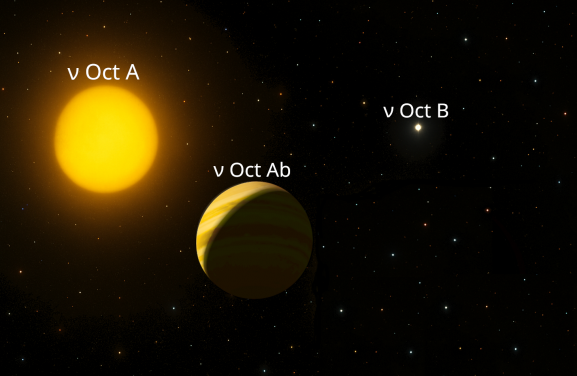Research Team at HKU Reveals Binary Star Evolution’s Impact on Retrograde Planet Formation

An international research team, led by Professor Man Hoi Lee from the Department of Earth Sciences and the Department of Physics at The University of Hong Kong (HKU), has made significant discoveries regarding the formation of a retrograde planet in the nu Octantis binary star system. The findings, published in the journal *Nature*, provide insights into how the evolution of binary stars can influence planetary formation.
Overview of the nu Octantis System
The nu Octantis system comprises two stars: a primary subgiant, nu Oct A, which has a mass approximately 1.6 times that of the Sun, and a secondary star, nu Oct B, with a mass around half that of the Sun. The two stars orbit each other with a period of 1,050 days.
Discovery of the Jovian Planet
Dr. David Ramm, a co-author of the study, originally identified a Jovian planet with a mass twice that of Jupiter in 2004 during his doctoral research. This planet is thought to orbit nu Oct A within a timeframe of 400 days, but its unusually wide orbit poses questions about its retrograde motion, which is defined as moving in the opposite direction of its binary star companions. Such configurations have not been well documented and present theoretical challenges.
Confirmation of the Planet’s Existence
To confirm the planet’s existence and its retrograde orbit, the research team conducted extensive radial velocity observations using the European Southern Observatory’s HARPS spectrograph. The analysis of data collected over an 18-year period demonstrated stable fits that are consistent with a retrograde orbit nearly aligned with the binary’s orbital plane.
Characteristics of the Secondary Star
The study also focused on the nature of the secondary star, nu Oct B. Based on mass estimates, it could either represent a low-mass main-sequence star or a white dwarf. The findings suggest that nu Oct B has likely lost a significant portion of its mass and has transitioned into a white dwarf state, which alters the system’s dynamics considerably.
Adaptive Optics Imaging
To determine the exact characteristics of nu Oct B, the research team employed adaptive optics imaging using the Very Large Telescope. These observations indicated that nu Oct B was faint or undetectable, reinforcing the hypothesis that it is likely a white dwarf. Further analysis implies that the initial mass of nu Oct B may have been approximately 2.4 times that of the Sun, evolving into its current state approximately two billion years ago.
Theoretical Implications of the Retrograde Planet
The researchers posited that the retrograde planet may have formed from material that was ejected from nu Oct B or that it may have been captured from a prograde orbit into a retrograde path following nu Oct B’s mass loss.
Significance of the Study
This study enhances the understanding of planetary formation in binary systems with evolved stellar components and underscores the importance of high-precision observational techniques and collaborative research methodologies in investigating such complex systems.
Publication Details
For further details, the journal article titled “A retrograde planet in a tight binary star system with a white dwarf” is available in the journal *Nature*.
(Source: The University of Hong Kong)




